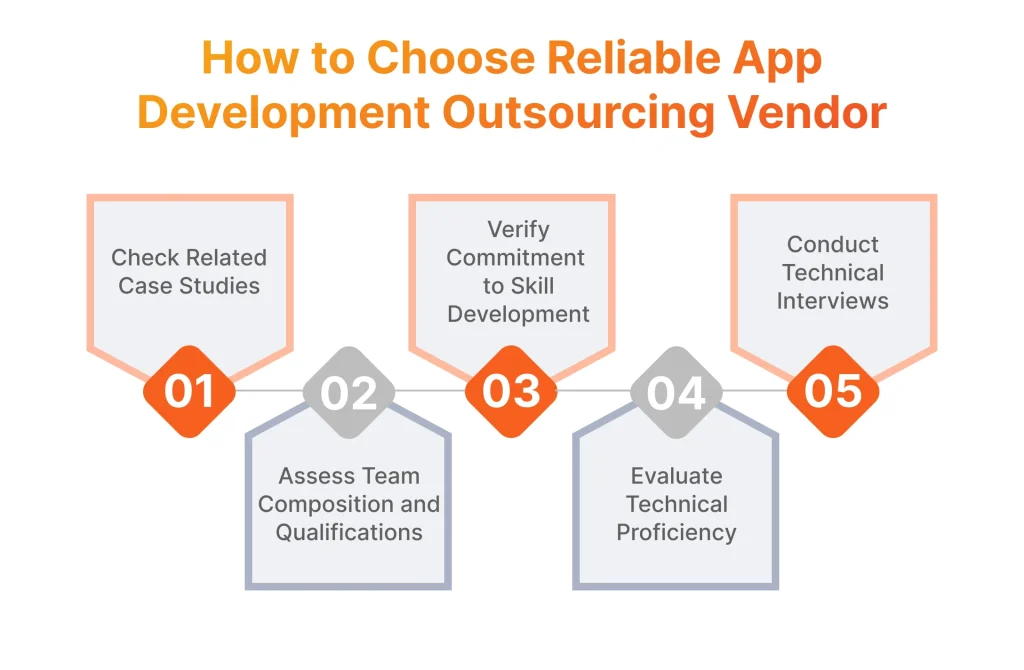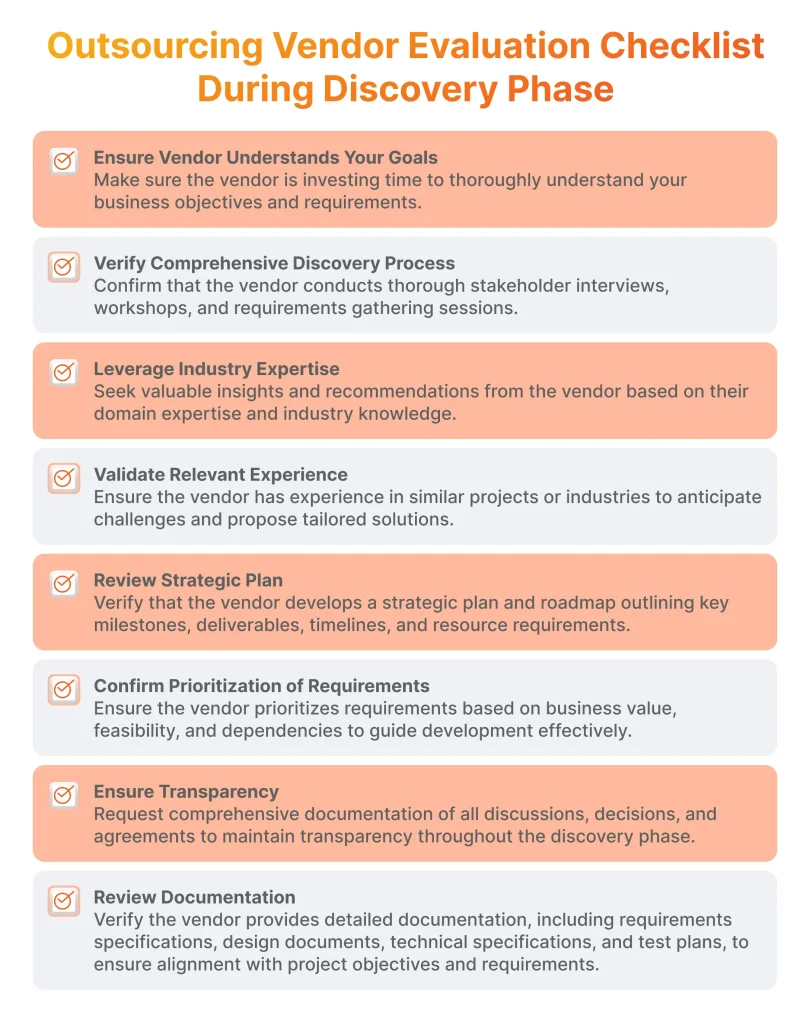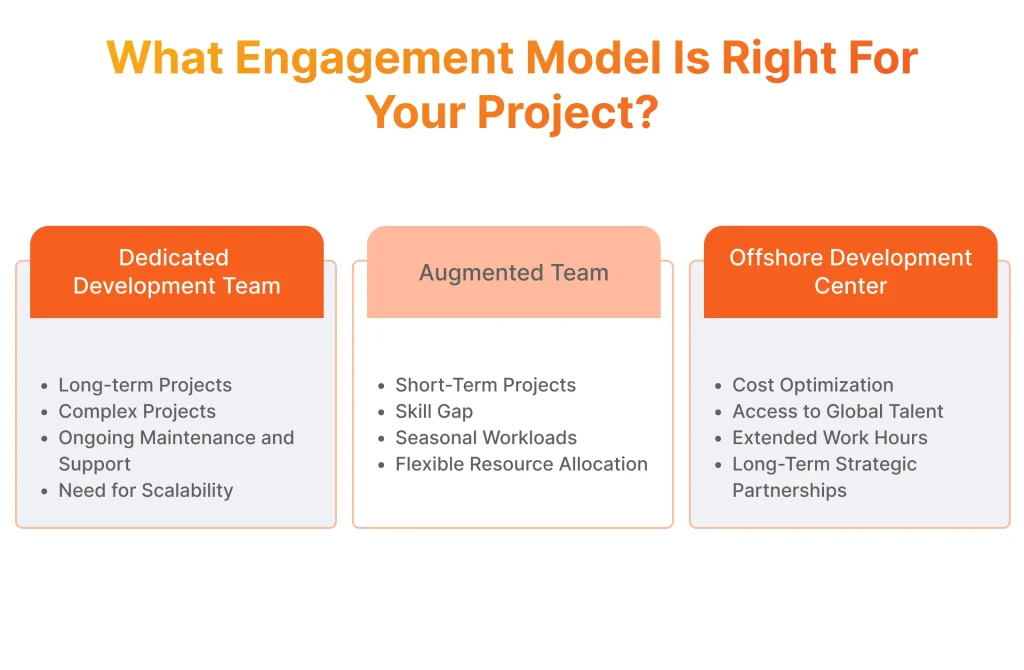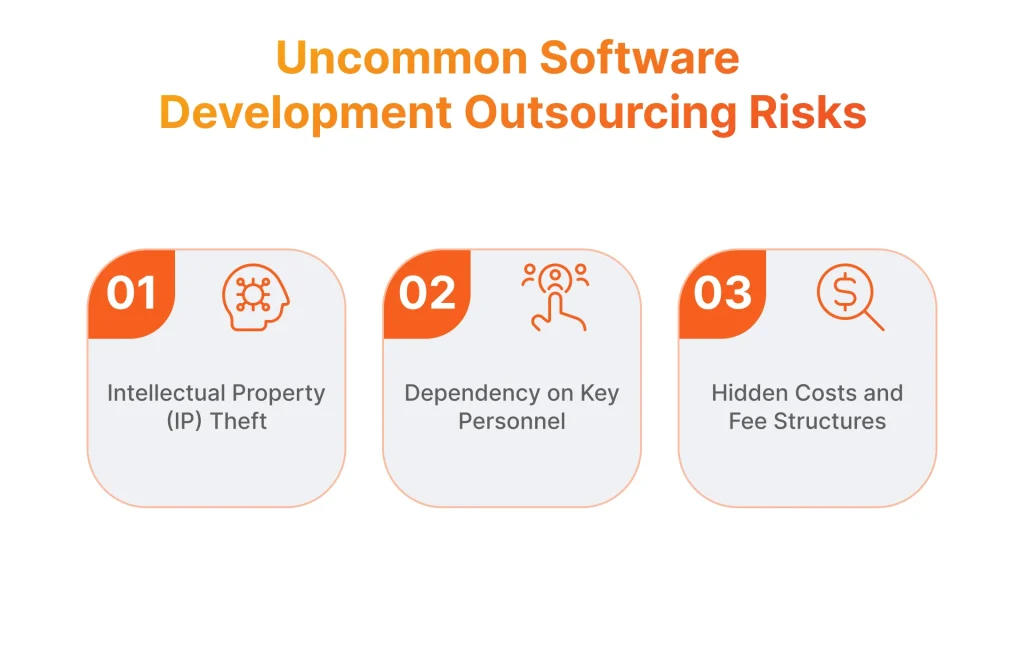Given the widespread prevalence and extensive scope of software outsourcing, it’s a factor that anyone considering to outsource app development should take into account. According to Statista, the anticipated revenue in the application outsourcing sector is expected to achieve a milestone of US$121.60 billion by the year 2024.
Clients increasingly seek application outsourcing services that provide cost savings on IT while maintaining quality. With numerous companies offering these services, it’s crucial to know how to enroll in such a strategic partnership, so for this goal, we have prepared six tips on how to outsource app development.
Tip 1: Choose The Location Wisely
Distributed software development is a popular decision for many businesses today. Therefore, selecting the optimal destination to outsource mobile app development is a critical move that can significantly impact the success of your project. Several key factors must be carefully considered to ensure a successful collaboration. From skillset availability to cost-effectiveness, each aspect plays a crucial role in determining the suitability of a location.
Latin America (LATAM)
Latin America can be a preferred choice for clients from North America due to its cultural and time zone alignment. It facilitates seamless collaboration, effective communication, timely project management, ultimately leading to enhanced project outcomes.
Tech Talent Availability
With a tech talent pool nearing 2 million professionals, Latin America stands out as a promising destination for app development outsourcing. Statista reports that in 2022, Brazil led the Latin American region with the largest information technology market, followed by Mexico and Peru. Here are also some important data from the report:
- Brazil’s IT market garnered a total value of 45 billion U.S. dollars.
- Mexico secured the second position with an IT market valued at 28 billion U.S. dollars
- Peru’s IT market stood at a comparatively modest 6.5 billion U.S. dollars
Main Skills
Developers in LATAM often possess expertise in web and mobile application development. According to statistics, the top five most popular programming languages in Latin America are:
- HTML – 273.8k;
- CSS – 249.9k;
- JavaScript – 247.1k;
- Python – 122.6k;
- Java – 114.7k.
Additionally, the most utilized frameworks include React, Express, Angular, Spring Boot, and Next.js.
Rates
As for the Latin American app developers rates, the majority of tech companies represented on Clutch charge $25-49 per hour. This makes the LATAM region a compelling option for app development outsourcing, particularly for North America, where the average software development hourly rate is $50 – $150.
Asia
Despite significant cultural and time zone differences between Asia and the US or Western Europe, the IT market in Asia remains a top choice for outsourcing app development due to its extensive talent pool and cost-effectiveness. Moreover, developers are highly adaptable to client preferences and adept at aligning working hours, enabling seamless communication and collaboration.
Tech Talent Availability
According to Research and Markets’ report, the Asia Pacific custom software development market is projected to experience a compound annual growth rate (CAGR) of 20.9% during the forecast period (2022-2028). China, Japan, and India emerge as the leading countries in this region for outsourcing app development companies.
- China led the Asia Pacific custom software development market by country in 2021, reaching a market value of $7.1 billion by 2028.
- Japan is experiencing a CAGR of 20.1% during the period of 2022-2028.
- The Indian market is expected to demonstrate a CAGR of 21.6% during the same timeframe.
Main Skills
Asian developers are known for their proficiency in software development, QA/testing, and IT infrastructure. They are often a preferred choice to outsource mobile app development. The most popular programming languages for software app development in the Asia Pacific region include Java, JavaScript, Python, C++, and PHP.
Rates
Most Asian app development companies listed on Clutch have the hourly rate range of $25 – $49, making it an affordable choice to outsource app development.
Western Europe
Western Europe is an excellent choice to find skilled developers for projects. While time zone alignment with the United States may pose challenges, companies within the region can find outsourcing desktop, web, or mobile app developers from neighboring countries quite convenient. Cultural similarities and a strong emphasis on professionalism make Western Europe well-suited for both US-based and European projects.
Tech Talent Availability
According to Deloitte’s Global outsourcing survey, the leading Western European countries to outsource app development include the UK, Ireland, and Germany.
- In Ireland, ICT exports grew by 158% from 2017 to 2021.
- In Germany and the UK, ICT exports grew by 39% each in the same period.
Main Skills
Developers in Western Europe possess expertise in various technologies and specialize in niche areas like AI, IoT, and blockchain. According to Enterprise App Statistics, the programming languages commonly used in these countries are:
- Python
- Java
- JavaScript
- C#
- R
- C/C++
Rates
According to Clutch, the average rate range for software developers in Western Europe is $50-$99. This high figure reflects the region’s elevated cost of living and skilled labor.
Eastern Europe
Eastern Europe’s software development appeal to enterprises from North America and Western Europe extends beyond its robust tech ecosystem and encompasses the diverse industry expertise of the local workforce. With numerous vendors handling projects across several sectors like financial services, IT, business services, healthcare, and eCommerce, the region offers specialized offshore software development and industry compliance in addition to cultural affinities and significant overlap in working hours.
Tech Talent Availability
According to a Statista report, revenue in the software market in Eastern Europe is expected to reach $9.19 billion in 2024, with the majority of revenue being generated in the United States. Ukraine, Poland, and Romania are among the popular destinations for desktop, web, and mobile development outsourcing in Eastern Europe.
- Poland plays a significant role in Eastern European IT, contributing 8% to GDP. In 2021, its IT exports reached 10 billion euros, projected to rise to 13 billion by 2026. IT outsourcing revenue is expected to reach $2.5 billion in 2023.
- Ukraine’s IT sector saw a notable surge, contributing $6 billion to the country’s export earnings during the initial ten months of 2022, reflecting a significant 10% increase compared to 2021.
- The Romanian IT market reached a valuation of €4.9 billion, accounting for 6.2% of the country’s GD in 2022.
Main Skills
Eastern European developers are proficient in multiple programming languages, including:
- JavaScript
- PHP
- Java
- Python
- .Net
Rates
According to Clutch, the rate range for Eastern European developers is $50-$99. While rates in Eastern Europe surpass those in Asia, they remain competitive compared to Western Europe, striking a balance between quality and cost-effectiveness.
We are proof that collaborating with international clients can yield productive and streamlined outcomes. As an illustration, an Israeli petcare company asked us to outsource mobile application development for computer-vision powered API creation. Through this initiative, we facilitated the building of a resilient neural network, enabling rapid image analysis and minimizing manual intervention. Additionally, we introduced an AI-supported remote veterinary service as a premium feature, thereby generating an extra revenue stream for our client.
Tip 2: Choose Reliable Tech Vendor with Niche Expertise
In addition to technical proficiency and location, it’s crucial to ensure your vendor has expertise in your specific niche. It allows desktop, web and mobile app development agencies to understand industry-specific challenges in the product development process and deliver tailored, high-quality solutions. Additionally, expertise in specific industries ensures compliance with regulatory requirements.

Below are tips to help you select a vendor with demonstrated expertise in your domain.
To be able to harness valuable industry-specific expertise, look for an app development company with at least 5+ years’ experience in delivering solutions to your industry. Check out their related case studies to see the precise role of the company in implementing the projects they have delivered to your industry.
Also, see if the expertise and experts they have can be regarded as an industry-related practice: continuity can mean all the difference in the ability of an app development company to mobilize the expertise you need and put it at your disposal when required. Sometimes, it appears that the app development outsourcing company you’ve approached does have one or more relevant projects in their portfolio, but no longer employs the actual knowledge holders, so check this point as well.
Assess Team Composition and Qualifications
The composition of the team is paramount to ensure your app development project is equipped with the right skillset. Ensure the team has a diverse array of experts, including designers, developers, architects, data scientists, QA engineers, or specialists in the specific technologies relevant to your project. Scrutinize their qualifications, certifications, and experience levels, especially in roles crucial to your project’s success within the domain.
For example, when selecting a tech vendor to outsource mobile app development for payment software, look for developers proficient in Java/Kotlin (for Android) or Swift/Objective-C (for iOS) for mobile coding and experienced in integrating payment APIs. You may also need security experts with certifications like CISSP. Additionally, ensure the presence of backend architects capable of designing scalable infrastructures and compliance specialists well-versed in regulatory requirements.
Verify Commitment to Skill Development
When outsourcing app developers, it’s crucial to delve into their commitment to continuous improvement. Inquire about their dedication to ongoing training and skill development initiatives. Look for tangible evidence of their efforts, such as participation in industry conferences, workshops, or online courses, and inquire about any industry certifications held by their team members.
For instance, when outsourcing mobile app development for iOS, companies should look for certifications such as Apple Developer Program Membership, Apple Certified iOS Developer, Swift Developer Certification.
Evaluate Technical Proficiency
To gauge a vendor’s technical proficiency, request access to sample code, demos, or prototypes they have developed. This allows you to evaluate their capabilities firsthand and assess their adherence to best practices within the niche technology. Reviewing their portfolio of past projects, particularly those similar to yours, provides further insight into their expertise and the quality of their work. Suppose you’re planning to outsource mobile app development of a banking software. You might ask to see a prototype of a mobile banking application they’ve worked on, showcasing features such as account management, fund transfers, bill payments, and security measures like two-factor authentication.
Conduct Technical Interviews or Assessments
Technical interviews are invaluable tools for evaluating a vendor’s expertise. If you want to be fully aware of what your vendor can bring to your project, engage in discussions on specific technical challenges. Assess their problem-solving skills, ability to communicate technical concepts clearly, and their approach to handling complex scenarios. Thus, you will gain a clearer understanding of their suitability for addressing your project’s requirements and challenges.
For example, when you decide to outsource mobile app development, the evaluation of a vendor’s expertise for a document management software development can include presenting specific challenges like data security, collaboration features, and version control.
Additionally, when considering hiring project managers with the mobile app development team, evaluate their proficiency in Scrum and Agile methodologies. This involves assessing their understanding of Agile principles, such as iterative development, collaboration, and continuous improvement, as well as their ability to effectively implement Scrum practices, including sprint planning, daily stand-ups, and sprint retrospectives. Project managers with strong skills in Scrum and Agile methodologies can help ensure that the app idea is delivered up to the requirement.
Interested in learning how to hire a dedicated development team?
Discover all the essential details in our comprehensive guide!
Tip 3: Never Neglect the Discovery Phase
The discovery phase of an outsourced project lays down the essential groundwork upon which the entire project’s success hinges. We have previously discussed the significance of this phase in our discussion of 6 tips to assist CTOs in outsourcing product development. And again, we want to highlight that with a close collaboration between stakeholders and app development companies, it is possible to establish a comprehensive roadmap, outlining the project scope, goals, and potential challenges.

Oleksadr Boyko
Delivery Director at SPD Technology
“The discovery stage is about seizing a crucial opportunity to anticipate and address potential risks, align expectations, and foster a shared understanding among all stakeholders. This initial phase sets the tone for the entire app development process, ensuring that everyone is on the same page.”
To ensure that you are confident in your team of choice, here is a checklist outlining how to confirm that the vendor is aligning your project on the right path.

Tip 4: Choose the Right Engagement and Delivery Model
Choosing the appropriate engagement model in software development ensures alignment with project requirements, maximizes efficiency, controls costs, and fosters effective collaboration between the client and the outsourcing team. If you’re still uncertain about which model suits your project best, the decision points below will assist you in selecting a preferred one.

Dedicated Development Team
If you want to hire IT specialists to focus solely on a specific project, your choice may lean towards the dedicated team model. This approach grants you access to a talent pool, while you still can have control over dedicated development team management. The team operates autonomously, utilizing their skills and expertise to develop the desired product without the need for additional manpower.
The dedicated team model is suitable for:
- Complex Projects: The dedicated app development team model allows businesses to assemble a skilled and cohesive team capable of tackling intricate challenges with consistency. The members of the team stay on the same page during the project and can efficiently approach problem-solving.
- Ongoing Maintenance and Support: By engaging a dedicated team, companies ensure timely response to maintenance needs and ongoing support, minimizing downtime and maximizing system reliability. The team remains readily available to address any issues that may arise.
- Need for Scalability: Whether ramping up for a new project initiative or downsizing after project completion, businesses can adjust the team size quickly and efficiently without being tied to long-term commitments.
- Long-term Projects: By hiring a dedicated app development team to work exclusively on projects, companies ensure consistent progress and sustained focus over an extended period. The team becomes deeply familiar with the project’s intricacies, fostering efficiency and enabling seamless collaboration.
For more than ten years, we have partnered with Mogami, a US-based Fintech company, on the development of a personal finance management application. SPD Technology provided mobile app development outsourcing services to build a robust and feature-packed iOS and Android application, which has garnered a loyal user base. Our successful integration of the app with the MX solution has paved the way for its adoption by banking institutions. This strategic initiative positions our client for promising opportunities to effectively market the solution in the Financial Services sector.
Augmented Team
If you need to enhance the in-house team by integrating external resources, IT staff augmentation will suit you. Rather than hiring more mobile app developers, designers, or QA engineers, you can opt for temporary or contract workers to address specific skill deficiencies, fulfill project requirements, or manage heightened workloads.
Staff augmentation suits:
- Short-Term Projects: Businesses can quickly augment their in-house development team with external specialists to address project requirements without the need for long-term commitments.
- Skill Gap: By augmenting an internal team with external specialists possessing the required skills, businesses can access the expertise needed to enhance their project capabilities without the need for extensive training or recruitment efforts.
- Seasonal Workloads: By leveraging external resources during peak periods, businesses can maintain productivity, meet project deadlines, and deliver quality outcomes without overburdening their internal team.
- Flexible Resource Allocation: Companies can scale their workforce up or down based on project requirements without incurring significant overhead costs associated with hiring full-time employees.
Offshore Development Center (ODC)
For instance, if you need to create a specialized mobile development company or team in a foreign location apart from your home country, setting up an offshore mobile app development center will be the best choice. This center functions as a deliberate expansion of the internal development capabilities, offering mobile application development outsourcing with cost-efficient and resourceful manpower and infrastructure.
The ODC engagement model is ideally suited for:
- Cost Optimization: By establishing an ODC, companies can access skilled professionals at competitive rates, significantly reducing development costs while maintaining high-quality standards.
- Access to Global Talent: By setting up an ODC, companies can tap into the expertise of professionals from around the world, ensuring access to the right talent for their project requirements.
- Extended Work Hours: Having an ODC in a location with a different time zone ensures continuous development and support coverage, even outside regular business hours. In such a way businesses accelerate project timelines and improve responsiveness.
- Long-Term Strategic Partnerships: Collaboration with ODC enables businesses to align with their offshore partner’s expertise and capabilities, fostering a mutually beneficial relationship focused on achieving shared goals and objectives.
Seeking efficient ways to set up an offshore development center?
Discover all the intricacies in our article!
Tip 5: Set Realistic Budget and Timelines Expectations
Setting realistic budget and timeline expectations nurtures a transparent and collaborative relationship between the client and the outsourcing team. It facilitates efficient project management in terms of time and budget, whether you’re hiring software developers for a startup or an established product.
Below are some common situations that could result in setting unrealistic budget and timeline expectations when you outsource app development, along with tips on how to address each scenario.
Failure to Consider External Factors
Situation: Failure to consider external factors such as market trends, regulatory changes, or third-party dependencies can significantly impact project delivery timelines. Market shifts or regulatory updates may introduce additional challenges that affect development progress and require adjustments to the project plan. Additionally, dependencies on third-party partners can lead to delays if not managed effectively.
Tip: It’s essential to stay informed about relevant industry trends, market dynamics, and regulatory requirements that may influence the project timeline. Proactively monitoring these external factors allows for better risk assessment and mitigation strategies. Establishing clear communication channels with third-party vendors or partners enables ongoing collaboration and ensures timely resolution of any dependency-related issues.
Over-Optimistic Assumptions
Situation: Being too confident about fast development speed or enhanced resource productivity can lead to unrealistic expectations and potential setbacks or delays. Ignoring the possibility of unforeseen challenges (e.g. unexpected bugs, changes in project requirements, team turnover, delays from third-party vendors, etc.) during the app development process can result in missed deadlines and budget overruns.
Tip: Always take into account historical data, industry benchmarks, and potential risks that may impact project progress. By leveraging past project experiences and lessons learned, software engineers can improve estimation accuracy and account for potential setbacks or delays. At the same time, regularly reassessing and adjusting budget and timeline expectations based on evolving project dynamics helps ensure alignment with project goals and objectives.
Inadequate Contingency Planning
Situation: When you outsource app development and fail to allocate sufficient contingency reserves for unforeseen events, delays, or changes, you can leave the project vulnerable to disruptions and budget overruns. Without proper planning for contingencies, even minor setbacks can escalate into major issues that derail the project timeline and exceed the allocated budget.
Tip: Include contingency buffers in the project timeline and budget to account for uncertainties and mitigate risks. These reserves should be based on a thorough risk assessment and reflect the likelihood and potential impact of multiple risks on project delivery. In addition to contingency buffers, leveraging a risk management framework allows for the systematic identification, assessment, and potential risks planning.

Oleksadr Boyko
Delivery Director at SPD Technology
“During outsourcing mobile app development, we encountered unexpected delays due to changes in third-party API specifications. To address this, we had previously established a contingency plan that included allocating additional development resources and extending the project timeline. This allowed us to adapt quickly to the changes without compromising the quality of the app or exceeding the budget.”
Tip 6: Know Uncommon Software Development Outsourcing Risks
Before desktop, web, or mobile app development outsourcing, it is essential to familiarize yourself with the potential complications that may arise and develop strategies to mitigate them effectively.

Below, we provide you with a list of common risks with examples so that you can develop contingency plans and ensure the successful delivery of your project.
Intellectual Property (IP) Theft
- Risk: Imagine a company outsources mobile app development of a proprietary algorithm for their mobile app to a third-party vendor. Without proper safeguards in place, the outsourcing partner could unlawfully share or use this algorithm for their own purposes or sell it to other parties.
- Impact: The company could suffer a loss of competitive advantage if their unique algorithm is exploited by competitors. Moreover, legal disputes may arise, leading to costly litigation and potential damage to the company’s reputation.
- Mitigation: The company should implement robust IP protection measures. This includes drafting clear contractual agreements that specify ownership of intellectual property rights and restrict the unauthorized use or disclosure of proprietary information. Additionally, non-disclosure agreements (NDAs) should be signed before outsourcing mobile app development to protect sensitive information. Furthermore, ensuring that the development environment is secure, with restricted access to code repositories and sensitive data, can help prevent unauthorized access and misuse of intellectual property.
- Risk: Let’s say a company enters into an outsourcing mobile app development agreement with a vendor based on a seemingly straightforward pricing model, only to discover later that additional fees are incurred for essential services or unexpected tasks.
- Impact: Budget overruns due to unanticipated pricing can strain the company’s financial resources and lead to project delays or cancellations. Moreover, disputes arising from ambiguous mobile development outsourcing cost structures can damage the client-vendor relationship and hinder collaboration on future projects.
- Mitigation: The company should seek clarity on cost breakdowns for services, additional work, or change requests to avoid any surprises later on. On top of that, establishing clear mechanisms for handling scope changes and cost adjustments can help ensure that any deviations from the original agreement are addressed promptly and transparently.
Dependency on Key Personnel
- Risk: Consider a scenario where a software development company relies heavily on offshore mobile app developers who possess specialized skills and knowledge critical to the project’s success. If these key individuals unexpectedly leave the project or become unavailable due to illness or other reasons, it could disrupt project continuity and lead to delays in execution.
- Impact: Without adequate contingency plans or succession strategies in place, the outsourced mobile app development may suffer from knowledge loss, decreased productivity, and missed deadlines.
- Mitigation: Ensuring knowledge sharing and documentation of critical processes can help distribute expertise across the offshore mobile app development team and reduce reliance on individual contributors. Encouraging cross-training and skill development among team members enables others to step in if key personnel are unavailable.
Conclusion
For those considering desktop, web, or mobile app development outsourcing, we’ve provided comprehensive tips to guide your decision-making process. Begin by selecting a partner location based on factors like expertise, rates, and cultural and timezone alignment. Next, thoroughly vet the skills of potential team members to ensure they match your project requirements. It’s also crucial to outline project requirements clearly before initiating the project to ensure understanding among all involved parties.
To outsource app development, you also need to consider engagement models and decide whether you want working with a dedicated team, augmenting your staff, or establishing an offshore center. Additionally, to ensure timely and budget-conscious project delivery with full ownership, it’s essential to set realistic expectations for costs and required skills. Developing a contingency plan and understanding how to mitigate risks, such as IP theft and hidden costs, are also critical aspects to address in the outsourcing process.
With all of these considerations in mind, SPD Technology is here to assist you every step of the way. Don’t hesitate to reach out to us if you require any assistance or further guidance.
FAQ
- How to Outsource App Development?
When outsourcing app development, start by clearly defining project requirements, including goals, features, and functionalities. Next, research reputable software development companies within a preferred location, focusing on their experience, niche expertise, and track record. Choose an engagement model for collaboration with the outsourced team. Lastly, remember to assess and plan for potential risks by developing a contingency plan for the project.
- How Much Does it Cost to Outsource App Development?
The cost of outsourcing app development varies based on factors such as project complexity, development platform, geographic location of the outsourcing partner, team composition, and project timeline. To determine the exact outsourced app development cost, discuss specific requirements with potential partners and request detailed project estimates.



